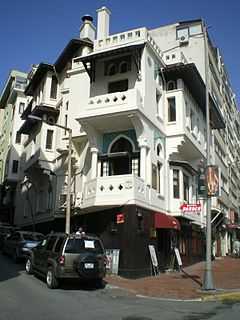Vedat Tek
| Vedat Tek | |
|---|---|
| Born |
1873 Istanbul |
| Died |
1942 (aged 68–69) Istanbul |
| Nationality | Turkish |
| Alma mater |
Académie Julian, Paris École Centrale Paris and Ecole des Beaux Arts, Paris, France |
| Occupation | Architect |
| Buildings |
Second Turkish Grand National Assembly Building, Ankara[1][2] Istanbul Main Post Office Building, Eminönü[1] Istanbul Land Registry and Cadastre Building, Sultanahmet |
Mehmet Vedat Tek (1873–1942) was a notable Turkish architect, who has been one of the leading figures of the First Turkish National Architectural Movement.
Early life and career
Being of Cretan Turkish origin, he was born in Istanbul to the governor of Baghdad Province Giritli Sırrı Pasha and composer Leyla Saz as their second son. His older brother was Yusuf Razi Bel (1870–1947), who later became an engineer.[3][4]
After finishing Galatasaray High School in Istanbul, he was sent to France for higher education. He attended Académie Julian for studies in painting and then studied at the École Centrale Paris graduating with a degree in civil engineering before he got his further education in architecture at the Ecole des Beaux Arts in Paris.[5][6] He became so the first formally educated Turkish architect.[7]
After returning home in 1897, Vedat Tek contributed with his projects to the forming of the first Turkish national architecture movement (Turkish: Birinci Ulusal Mimarlık)[1] along with Mimar Kemaleddin Bey.[5] He served awhile as the chief architect of the Engineering Corps at the Ministry of War. Later, Sultan Mehmet V appointed him chief court architect.[8]
He also gave lectures at Sanayi-i Nefise Mekteb-i (former Mimar Sinan University of Fine Arts) and Mühendis Mekteb-i Alisi (former Istanbul Technical University). Vedat Tek was one of the first Turkish lecturers at the Academy of Fine Arts.
Post Telegraph Ministry Architect He became popular architect because of his Kastomonu Government Office project. He became Post Telegraph ministry architect, in 1905.His assignmet was Istanbul Main Post Office which is his biggest position in his architectural career.
Chief Architect of Ottoman Palaces Vedat TEK became chief architect of palaces after Sultan Abdulhamit left the throne when Mehmet Reşat became sultan. While he is continuing his job, he restoreted about 20 palaces. By the way when Vahdettin became a Sultan he dismissed.
Republic Era After proclamation of the republic he was called out to Ankara. He built 2. TBMM building and Gazi Pavillion here.While he was preparing plans of Ankara Palas they give this project to Mimar Kemalettin.[9] He married to Firdevs. From this marriage, he had three daughters.[10]
Vedat Tek died in 1942 and was laid to rest at the Edirnekapı Martyr's Cemetery in Istanbul.
Projects and buildings

He was the architect of various beautiful buildings in Istanbul; some of his notable projects and buildings including:
- İzmit Clock Tower, İzmit (1901)[11]
- Kastamonu Government House, Kastamonu (1901),[1]
- Istanbul Main Post Office, Sirkeci (1905–1909),[1][5]
- Istanbul Land Registry and Cadastre Building, Sultanahmet (1908),[5]
- House of Vedat Tek, Nişantaşı (1913) (used today as a restaurant),[12]
- Aviation Martyrs' Monument, Fatih (1914–1916)[13]
- Haydarpaşa Ferryboat Pier, Haydarpaşa (1915–1917)[14][15]
- Moda Ferryboat Pier, Moda, Hadıköy (1917) (used since July 1, 2001 as a restaurant),[16]
- Doğancılar Public Park, Üsküdar (1920),[17]
- Çankaya Gazi Mansion, Ankara (1924),[18]
- Second Turkish Grand National Assembly Building, Ankara (1924).[1][2] (used since October 20, 1980 as the Republic Museum)[19]
- Ankara Palas, Ankara - Designed in 1924 by him as Ministry of Health building, however completed in 1928 by Mimar Kemaleddin Bey as a hotel for the members of the Turkish Grand National Assembly. It is used today as an official state guest house.[2]
The First National Architecture was characterized by the creation of entirely new designs with elements taken off the Seljuk and Ottoman architecture. The buildings all over the country designed in that style had a sweeping overhanging roof, tiled panels on the façade, large arched windows and jutting semi-circular ornaments in common.[1]
Vedat Tek was known for his colorful and ornate style in architecture.
See also
References
- ↑ 1.0 1.1 1.2 1.3 1.4 1.5 1.6 "Captivating Kastamonu". Sunday's Zaman. 2009-01-25. Retrieved 2010-09-01.
- ↑ 2.0 2.1 2.2 Yale, Pat (2010-01-10). "Climbing through Ankara's history: From Ulus to the Kale". Retrieved 2010-09-01.
- ↑ Çetin, Mahmut (1997). Boğaz'daki aşiret (in Turkish). Edile. p. 99.
- ↑ Neyzi, Nezihe; Leyla Neyzi (1999). Küçük hanım'dan rubu asırlık adam'a: Nezihe Neyzi'den oğlu Nezih Neyzi'ye (in Turkish). p. 20.
- ↑ 5.0 5.1 5.2 5.3 Ergüvenç , Yılmaz (2007-03-30). "Son Yüzyılın Türk Mimarlık Sanatına Genel Bir Bakış (II)". Kent Haber (in Turkish). Retrieved 2010-09-01.
- ↑ Beck, Christa; Christiane Forsting (1997). Istanbul: an architectural guide. p. 92. ISBN 3-89508-638-X.
- ↑ Architecture education in the Islamic world: proceedings of seminar ten in ... Aga Khan Award for Architecture (Organization). 1986. p. 135.
- ↑ Sözen, Metin; Mete Tapan (1973). 50 yılın Türk mimarisi (in Turkish). p. 101.
- ↑ Wikipedia Turkish Page About Vedat Tek
- ↑ Türk dili: dil ve edebiyat dergisi (in Turkish). 634-636. Türk Dil Kurumu. 2004. p. 614.
- ↑ Altan, Mehmet (2008-10-26). "Yaz saati uygulaması faydalı mı?". Haber 10 (in Turkish). Retrieved 2010-09-02.
- ↑ Özbey, Savaş (2006-12-15). "Savaş askere gitti hiper bize emanet". Hürriyet (in Turkish). Retrieved 2010-09-02.
- ↑ "Tayyare Şehitleri Anıtı". Kent Haber (in Turkish). 2008-02-11. Retrieved 2010-09-02.
- ↑ "Kütahya'nın adi, seramikle anlatılan rivayete dayanıyor" (in Turkish). TürkiyeTurizm.com. Retrieved 2010-09-02.
- ↑ Freely, John (2000) The companion guide to Istanbul and around the Marmara 428p 264pp
- ↑ "İçki yasağı zirveye çıktı". Turizmde Bu Sabah (in Turkish). 2008-08-26. Retrieved 2010-09-02.
- ↑ "Bölgemizin Tarihçesi-Doğancılar" (in Turkish). Soyak Bağlarbaşı Evleri Blog. 2008-02-29. Retrieved 2010-09-02.
- ↑ Öndin, Nilüfer (2003). Cumhuriyet'in kültür politikası ve sanat, 1923-1950 (in Turkish). p. 78.
- ↑ "Cumhuriyet Müzesi". Kent Haber (in Turkish). 2008-02-05. Retrieved 2010-09-02.
- Tonguç, Saffet Emre; Pat Yale (2010). Istanbul Hakkında Herşey (in Turkish). Istanbul: Boyut Yayınları.
|
